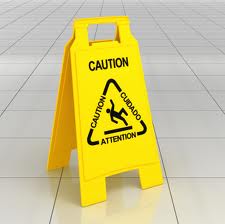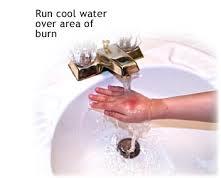Protect your family from injuries at home, such as falls, poisoning, burns, and choking/suffocation/strangulation by following these simple steps:
Falls

An injury-producing fall can happen at any age. Falls are the leading cause of nonfatal injuries in people ages 25 to 54.
Prevent falls at home.
- Clear the clutter. Make sure stairways, pathways, and living areas are clear from clutter.
- Keep electrical and telephone cords out of walkways.
- Make sure all floor boards are even and rugs are secured to the floor. Use non-skid floor wax.
- Know where your pets are. Pets are responsible for more than 86,000 fall-related injuries each year. Also watch for pet dishes and toys, which are tripping hazards.
- In the bathroom; remove soap build up in tub or shower on a regular basis, place non-slip strips in the bath/shower, and secure bath mats with non-slip rug tape.
- If you use a step stool, get one with a bar to hold on to. Never use a chair.
- Immediately clean up any liquid or food spilled on the floor.
- Shed some light. Sure it is nice to cut your energy bill by turning off some lights, but don't take it so far that your home is a hazard. Put in a night-light so you can see where you are walking.
Prevent falls with children.
- Never leave babies unsupervised on any piece of furniture including changing tables, beds, and sofas.
- Use safety straps and other safety features on high chairs, shopping carts, and changing tables.
- Use safety covers or install padding on sharp corners.
- Install window guards on all windows above the first floor.
- Do not rely on window screens to keep children from falling out.
Poisoning
Drugs and Medicines
- Only take prescription medication that are prescribed to you by a healthcare professional. Always follow directions and read precautions on the label of all medications.
- Keep medications and vitamins out of the reach of children.
- Do not call medicine "candy".
- Use child-resistant packaging. Replace caps tightly.
- Dispose of unused, unneeded, or expired prescription drugs. Follow federal guidelines for how to do this (FDA's web site: Disposal of Unused Medicines). Participate in National Drug Take Back days.
Household Chemicals and Carbon Monoxide
- Always read the label before using a product.
- Keep all potential poisons up high and out of the reach of children. In a locked storage container would be best.
- Keep products in original containers. Do not use food storage containers to store poisonous substances.
- Never mix household products together.
- Wear protective clothing (gloves, long sleeves, long pants, socks, shoes) if you spray pesticides or other chemicals.
- Turn on the fan and open windows when using chemical products such as household cleaners.
Be Prepared

- Post the Poison Center phone number where everyone will see it (1-800-222-1222). The line is open 24 hours a day, 7 days a week.
- If a poisoning occurs, remain calm
- Call 911 if you have a poison emergency and the victim has collapsed or is not breathing. If the victim is awake and alert, dial 1-800-222-1222. Try to have this information ready:
- the victim’s age and weight
- the container or bottle of the poison if available
- the time of the poison exposure
- the address where the poisoning occurred
- Stay on the phone and follow the instructions from the emergency operator or poison control center.
- For more on Poison Prevention click here.
Burns
Protect loved ones from burns and injuries.
- Use pot holders when handling hot pots and pans. NEVER use damp towels.
- When frying foods containing water, take a step back from the stove. The water can cause oil to splatter.
- Steam from hot foods can cause serious burns. When opening lids, open away from you and allow steam to escape before looking in.
- Keep cloth and other combustible material away from cooking areas including stoves, grills, ovens and toasters.
- Unplug appliances when not in use and keep cords away from the stove, water and sink.
- When removing plugs from an outlet, don’t use wet hands or pull on the electrical cord.
- Wear close-fitting clothes (nothing loose or dangling) or roll up your sleeves when working near a stove or grill.
- Keep chemicals out of reach of children and in locked cabinets.
- Follow directions precisely when working with chemicals.
Keep children safe from burns.

- Reduce water temperature: Set the thermostat on your water heater at or below 120 F. Always test the water temperature before you put your children in the bathtub.
- Avoid hot spills. Don’t cook, carry, or drink hot beverages while holding a child. Keep hot liquids away from the edges of table and counters.
- When using the stove, turn pot handles inward and use the rear burners. Never leave a stove unattended.
- Establish ‘no’ zones. Block a child’s access to the stove and fireplace. Make sure to block access to heaters and water heaters as well.
- Unplug irons, including curling irons and flat irons when you are not using them. When in use, keep children away from irons.
- Test food temperature before giving a child food or liquids. Never warm a baby’s bottle in the microwave.
- Choose a cool-water humidifier or vaporizer. If using a hot-steam vaporizer, keep it away from children’s reach.
- Place covers over outlets and keep electrical cords out of children’s reach. An electrical burn can happen if a metal object is put into an outlet, or if children bite or chew on an electrical cord.
Treating burns.

Treatment for minor burns:
- DO NOT use ice. Ice can cause further damage. Instead, cool the burn. Hold under cold running tap water until the area is free from pain even after removal from the water. If this is not possible, cover with a cold compress.
- DO NOT apply butter or ointments. Instead, cover the burn with a sterile nonstick dressing and bandage. Do not use fluffy cotton or other material that may stick to or get lint in the wound.
- Take an over-the-counter pain reliever (aspirin, ibuprofen, naproxen, or acetaminophen). Use caution when giving pain reliever to children. Children covering from chickenpox or flu-like symptoms should never take aspirin.
- DO NOT break blisters. Broken blisters are more vulnerable to infection.
Treatment for major/severe burns:
- Call 911 or your local emergency number immediately
- Do not remove clothing that is stuck to the skin. However, do make sure the victim is no longer in contact with smoldering materials or exposed smoke or heat.
- Do not immerse large severe burns in cold water. This could cause a drop in body temperature (hypothermia) and deteriorate blood pressure and circulation causing shock.
- Check for responsiveness and signs of normal breathing. If there is no normal breathing begin CPR.
- Treat for shock: have the person lie on back, elevate legs if no trauma and maintain normal body temperature (cover with a sheet or blanket).
If you are unsure about the depth of the burn, treat it as a severe burn.
Choking, Suffocation, and Strangulation
Choking
Among children treated in emergency rooms for non-fatal choking incidents, almost 60% were food-related. Overall, 13% of cases involved swallowing coins and 19% involved gum or candy.
- Cut food for toddlers into tiny pieces.
- Have young kids eat in a high chair or at the table, not while lying down or playing.
- Keep small objects out of reach of young children.
- Buy age appropriate toys. Check for small parts or other potential choking hazards.
- Keep small magnets away from children. Inspect games for toys that include magnets. Seek medical attention immediately if you suspect that magnets have been swallowed.
What to do if a young child chokes:
If the child IS breathing, coughing or crying, the child may be able to dislodge the food by coughing.
- Check the child’s mouth for food; remove any food that you can see (scoop it out with your fingers).
- Stay with the child and watch to see if their breathing improves.
- If coughing has not removed the food and your child is not breathing easily, phone 911 for an ambulance.
If the child is NOT breathing.
- Call 911 for an ambulance.
- If the child is conscious, place them face down over your lap so that their head is lower than their chest.
- Give up to 5 sharp blows between the shoulder blades using the heal of your hand.
- Check the child’s mouth after each back blow and remove any food.
- If the child is still not breathing, commence CPR. The ambulance service operator will be able to tell you what to do next.
Strangulation
- Keep cords and strings, including those attached to window blinds out of your child’s reach.
- Remove necklaces, purses, scarves, helmets or clothing with drawstrings when children are playing or sleeping.
- Don’t tie string or ribbons to a pacifier or toy.
- Remove bibs before bedtime or nap.
Suffocation
- Do not allow infants or toddlers to sleep on sofas, chairs, regular beds or other soft surfaces.
- Never allow young children to play in poorly ventilated spaces such as laundry machines, car trunks, or toy chests.
- Always tie a knot in plastic bags before storing or throwing away, never allow children to play with plastic bags or plastic wrap.
- Other less obvious items that are potential suffocation hazards include pillows, bean bags, balloons, bedding, mattresses, old refrigerators, closed chest, etc.
Sources: Center for Disease Control and Prevention (www.cdc.org), National Safety Council (www.nsc.org) and Safe Kids Worldwide (www.safekids.org)
